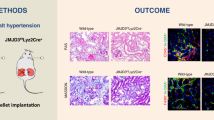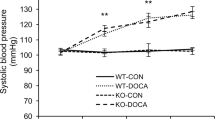Abstract
Recent studies have expanded our understanding of the actions of the mineralocorticoid receptor (MR) to a diverse array of tissue types that differ substantially from the epithelial cells of the renal nephron. In these cell types the role of the MR has been largely, but not exclusively, defined in terms of pathogenic signalling pathways leading to tissue injury and remodelling. Macrophages and cardiomyocytes are two cell types in which the MR plays a central role in the cardiac tissue response to injury, renovascular hypertension and oxidative stress for example. Macrophages are critical for resolution of tissue injury and wound healing and their pleiotropic actions are central to the development of many forms of heart, renal and vascular disease. The MR in cardiomyocytes is not only essential for the chronotropic and ionotropic actions of mineralocorticoids in the short and longer term, but also for induction of hypertrophic and proinflammatory signalling programs. The present review discusses recent studies, presented at the Aldosterone and Hypertension Satellite of the 15th Asian-Pacific Congress of Hypertension, investigating new mechanisms for MR signalling in these cells and how their dysfunction contributes to the onset and progression of cardiovascular disease and heart failure.
This is a preview of subscription content, access via your institution
Access options
Subscribe to this journal
Receive 12 digital issues and online access to articles
$119.00 per year
only $9.92 per issue
Buy this article
- Purchase on Springer Link
- Instant access to full article PDF
Prices may be subject to local taxes which are calculated during checkout

Similar content being viewed by others
References
Beaumont C, Brillard JP, Millet N, De Reviers M. Comparison of various characteristics of duration of fertility in hens. Br Poult Sci. 1992;33:649–61.
Young M, Fullerton M, Dilley R, Funder J. Mineralocorticoids, hypertension, and cardiac fibrosis. J Clin Invest. 1994;93:2578–83.
Rocha R, Chander PN, Zuckerman A, Stier CT Jr. Role of aldosterone in renal vascular injury in stroke-prone hypertensive rats. Hypertension. 1999;33:232–7.
Young MJ, Funder JW. The renin-angiotensin-aldosterone system in experimental mineralocorticoid-salt-induced cardiac fibrosis. Am J Physiol. 1996;271:E883–8.
Melander A, Olsson J, Lindberg G, Salzman A, Howard T, Stang P, et al. 35th annual meeting of the European Association for the Study of Diabetes: Brussels, Belgium, 28 September–2 October 1999. Diabetologia. 1999;42:A1–A330.
Araki T, Shimizu M, Yoshio H, Ino H, Mabuchi H, Takeda R. Effects of angiotensin-converting enzyme inhibitor and aldosterone antagonist on myocardial collagen in cardiomyopathic hamsters. Jpn Circ J. 1995;59:213–8.
Klionsky DJ, Abdelmohsen K, Abe A, Abedin MJ, Abeliovich H, Acevedo Arozena A. et al. Guidelines for the use and interpretation of assays for monitoring autophagy (3rd edition). Autophagy. 2016;12:1–222.
Young M, Head G, Funder J. Determinants of cardiac fibrosis in experimental hypermineralocorticoid states. Am J Physiol. 1995;269:E657–62.
Selye H. Production of nephrosclerosis by overdosage with desoxycorticosterone acetate. Can Med Assoc J. 1942;47:515–9.
Simpson SA, Tait JF. The nature of the circulating hormones of the adrenal cortex in man. Arch Middx Hosp. 1953;3:209–18.
Simpson SA, Tait JF, Wettstein A, Neher R, Von Euw J, Reichstein T. [Isolation from the adrenals of a new crystalline hormone with especially high effectiveness on mineral metabolism]. Experientia. 1953;9:333–5.
Funder JW, Krozowski Z, Myles K, Sato A, Sheppard KE, Young M. Mineralocorticoid receptors, salt, and hypertension. Recent Prog Horm Res. 1997;52:247–60-62.
Struthers AD. Why does spironolactone improve mortality over and above an ACE inhibitor in chronic heart failure? Br J Clin Pharmacol. 1999;47:479–82.
Pitt B, Zannad F, Remme WJ, Cody R, Castaigne A, Perez A. et al. The effect of spironolactone on morbidity and mortality in patients with severe heart failure. N Engl J Med. 1999;341:709–17.
Pitt B, Remme W, Zannad F, Neaton J, Martinez F, Roniker B. et al. Eplerenone, a selective aldosterone blocker, in patients with left ventricular dysfunction after myocardial infarction. New Engl J Med. 2003;348:1309–21.
Zannad F, McMurray JJ, Krum H, van Veldhuisen DJ, Swedberg K, Shi H, et al. Eplerenone in patients with systolic heart failure and mild symptoms. N. Engl J Med. 2011;364:11–21.
Williams EM, Katholi RE, Karambelas MR. Use and side-effect profile of spironolactone in a private cardiologist’s practice. Clin Cardiol. 2006;29:149–53.
Libianto R, Fuller PJ, Young MJ, Yang J. Primary aldosteronism is a public health issue: challenges and opportunities. J Hum Hypertens. 2020.
Monticone S, D’Ascenzo F, Moretti C, Williams TA, Veglio F, Gaita F. et al. Cardiovascular events and target organ damage in primary aldosteronism compared with essential hypertension: a systematic review and meta-analysis. Lancet Diabetes Endocrinol. 2018;6:41–50.
Fuller P, Yao YZ, Yang J, Young M. Structural determinants of activation of the mineralocorticoid receptor: an evolutionary perspective. J Hum Hypertens. 2020;JHH-20-0126R.
Pearce P, Funder J. High affinity aldosterone binding sites (type I receptors) in rat heart. Clin Exp Pharmacol Physiol. 1987;14:859–66.
Gomez-Sanchez EP, Gomez-Sanchez CM, Plonczynski M, Gomez-Sanchez CE. Aldosterone synthesis in the brain contributes to Dahl salt-sensitive rat hypertension. Exp Physiol. 2010;95:120–30.
Funder JW, Pearce PT, Smith R, Smith AI. Mineralocorticoid action: target tissue specificity is enzyme, not receptor, mediated. Science. 1988;242:583–5.
Krozowski ZS, Rundle SE, Wallace C, Castell MJ, Shen JH, Dowling J, et al. Immunolocalization of renal mineralocorticoid receptors with an antiserum against a peptide deduced from the complementary deoxyribonucleic acid sequence. Endocrinology 1989;125:192–8.
Iqbal J, Andrew R, Cruden NL, Kenyon CJ, Hughes KA, Newby DE, et al. Displacement of cortisol from human heart by acute administration of a mineralocorticoid receptor antagonist. J Clin Endocrinol Metab. 2013;99:915–22. https://doi.org/10.1210/jc.2013-2049.
Mihailidou AS, Loan LeTY, Mardini M, Funder JW. Glucocorticoids activate cardiac mineralocorticoid receptors during experimental myocardial infarction. Hypertension 2009;54:1306–12.
Koning A, Buurstede JC, van Weert L, Meijer OC. Glucocorticoid and mineralocorticoid receptors in the brain: a transcriptional perspective. J Endocr Soc 2019;3:1917–30.
Rickard AJ, Morgan J, Tesch G, Funder JW, Fuller PJ, Young MJ. Deletion of mineralocorticoid receptors from macrophages protects against deoxycorticosterone/salt-induced cardiac fibrosis and increased blood pressure. Hypertension 2009;54:537–43.
Rickard AJ, Morgan J, Bienvenu LA, Fletcher EK, Cranston GA, Shen JZ, et al. Cardiomyocyte mineralocorticoid receptors are essential for deoxycorticosterone/salt-mediated inflammation and cardiac fibrosis/novelty and significance. Hypertension 2012;60:1443–50.
Usher MG, Duan SZ, Ivaschenko CY, Frieler RA, Berger S, Schutz G, et al. Myeloid mineralocorticoid receptor controls macrophage polarization and cardiovascular hypertrophy and remodeling in mice. J Clin Invest 2010;120:3350–64.
Bienvenu LA, Morgan J, Rickard AJ, Tesch GH, Cranston GA, Fletcher EK, et al. Macrophage mineralocorticoid receptor signaling plays a key role in aldosterone-independent cardiac fibrosis. Endocrinology 2012;153:3416–25.
Shen JZ, Morgan J, Tesch GH, Rickard AJ, Chrissobolis S, Drummond GR, et al. Cardiac tissue injury and remodeling is dependent upon mr regulation of activation pathways in cardiac tissue macrophages. Endocrinology 2016;157:3213–23.
Keidar S, Hayek T, Kaplan M, Pavlotzky E, Hamoud S, Coleman R, et al. Effect of eplerenone, a selective aldosterone blocker, on blood pressure, serum and macrophage oxidative stress, and atherosclerosis in apolipoprotein E-deficient mice. J Cardiovasc Pharmacol 2003;41:955–63.
Keidar S, Kaplan M, Pavlotzky E, Coleman R, Hayek T, Hamoud S, et al. Aldosterone administration to mice stimulates macrophage NADPH oxidase and increases atherosclerosis development: a possible role for angiotensin-converting enzyme and the receptors for angiotensin II and aldosterone. Circulation 2004;109:2213–20.
Pinto AR, Paolicelli R, Salimova E, Gospocic J, Slonimsky E, Bilbao-Cortes D, et al. An abundant tissue macrophage population in the adult murine heart with a distinct alternatively-activated macrophage profile. PLoS ONE 2012;7:e36814.
Frieler RA, Meng H, Duan SZ, Berger S, Schutz G, He Y, et al. Myeloid-specific deletion of the mineralocorticoid receptor reduces infarct volume and alters inflammation during cerebral ischemia. Stroke 2011;42:179–85.
Huang LL, Nikolic-Paterson DJ, Han Y, Ozols E, Ma FY, Young MJ, et al. Myeloid mineralocorticoid receptor activation contributes to progressive kidney disease. J Am Soc Nephrol 2014;25:2231–40.
Ong GS, Young MJ. Mineralocorticoid regulation of cell function: the role of rapid signalling and gene transcription pathways. J Mol Endocrinol 2017;58:R33–R57.
Oakley RH, Cruz-Topete D, He B, Foley JF, Myers PH, Xu X, et al. Cardiomyocyte glucocorticoid and mineralocorticoid receptors directly and antagonistically regulate heart disease in mice. Sci Signal 2019;12:577.
Bienvenu LA, Reichelt ME, Morgan J, Fletcher EK, Bell JR, Rickard AJ, et al. Cardiomyocyte mineralocorticoid receptor activation impairs acute cardiac functional recovery after ischemic insult. Hypertension 2015;66:970–7.
Rossier MF, Python M, Maturana AD. Contribution of mineralocorticoid and glucocorticoid receptors to the chronotropic and hypertrophic actions of aldosterone in neonatal rat ventricular myocytes. Endocrinology 2010;151:2777–87.
Fraccarollo D, Bauersachs J. Cardiomyocyte mineralocorticoid receptor function post myocardial infarction. Trends Cardiovasc Med 2011;21:42–7.
Young ME. Anticipating anticipation: pursuing identification of cardiomyocyte circadian clock function. J Appl Physiol 2009;107:1339–47.
Durgan DJ, Trexler NA, Egbejimi O, McElfresh TA, Suk HY, Petterson LE, et al. The circadian clock within the cardiomyocyte is essential for responsiveness of the heart to fatty acids. J Biol Chem 2006;281:24254–69.
Carter SJ, Durrington HJ, Gibbs JE, Blaikley J, Loudon AS, Ray DW, et al. A matter of time: study of circadian clocks and their role in inflammation. J Leukoc Biol 2016;99:549–60.
Bonaconsa M, Malpeli G, Montaruli A, Carandente F, Grassi-Zucconi G, Bentivoglio M. Differential modulation of clock gene expression in the suprachiasmatic nucleus, liver and heart of aged mice. Exp Gerontol. 2014;55:70–9.
Tanaka K, Ashizawa N, Kawano H, Sato O, Seto S, Nishihara E, et al. Aldosterone induces circadian gene expression of clock genes in H9c2 cardiomyoblasts. Heart Vessels 2007;22:254–60.
Ivy JR. Am J Physiol Renal Physiol. 2019;317:F1536–F1548.
Fletcher EK, Morgan J, Ray DW, Delbridge L, Fuller PJ, Clyne CD, et al. Cardiomyocyte transcription is controlled by combined MR and circadian clock signalling. J Endocrinol. 2019;241;17–29.
Young ME, Wilson CR, Razeghi P, Guthrie PH, Taegtmeyer H. Alterations of the circadian clock in the heart by Streptozotocin-induced diabetes. J Mol Cell Cardiol 2002;34:223–31.
Durgan DJ, Pulinilkunnil T, Villegas-Montoya C, Garvey ME, Frangogiannis NG, Michael LH, et al. Short Communication: ischemia/reperfusion tolerance is time-of-day-dependent. Circ Res 2010;106:546–50.
Joels M. Corticosteroids and the brain. J Endocrinol 2018;238:R121–R30.
Okamura H, Doi M, Yamaguchi Y, Fustin J-M. Hypertension due to loss of clock: novel insight from the molecular analysis of Cry1 /Cry2-deleted mice. Curr Hypertens Rep. 2011;13:103–8.
Krasinska B, Cofta S, Szczepaniak-Chichel L, Rzymski P, Trafas T, Paluszkiewicz L, et al. The effects of eplerenone on the circadian blood pressure pattern and left ventricular hypertrophy in patients with obstructive sleep apnea and resistant hypertension-a randomized, controlled trial. J Clin Med. 2019;8:1671.
Fletcher EK, Morgan J, Kennaway DR, Bienvenu LA, Rickard AJ, Delbridge LMD, et al. Deoxycorticosterone/salt-mediated cardiac inflammation and fibrosis are dependent on functional CLOCK signaling in male mice. Endocrinology 2017;158:2906–17.
Yang J, Fuller PJ, Morgan J, Shibata H, McDonnell DP, Clyne CD, et al. Use of phage display to identify novel mineralocorticoid receptor-interacting proteins. Mol Endocrinol 2014;28:1571–84.
Acknowledgements
MK is supported by a Monash Graduate Scholarship, JY is supported by a Vanguard Grant (NHF) and NHMRC MRFF Early Career Fellowship. MK is supported by a Monash Post Graduate Scholarship. JY is supported by funding from the NHF and Monash Partners, PJF is supported by NHMRC GNT1143840 and MJY is supported by Diabetes Australia and the Eleanor Baker and Elise Shaw Gender Equity Fellowship, Baker Heart Heart and Diabetes Institute.
Author information
Authors and Affiliations
Corresponding author
Ethics declarations
Conflict of interest
MJY, PJF and JY have received funding from Astra Zeneca but those specific studies are not part of the current review.
Additional information
Publisher’s note Springer Nature remains neutral with regard to jurisdictional claims in published maps and institutional affiliations.
This work was presented in part at the Aldosterone and Hypertension Satellite of the 15th Asian-Pacific Congress of Hypertension held in Brisbane, Australia from 24 to 27 November 2019.
Rights and permissions
About this article
Cite this article
Young, M.J., Kanki, M., Fuller, P.J. et al. Identifying new cellular mechanisms of mineralocorticoid receptor activation in the heart. J Hum Hypertens 35, 124–130 (2021). https://doi.org/10.1038/s41371-020-0386-5
Received:
Revised:
Accepted:
Published:
Issue Date:
DOI: https://doi.org/10.1038/s41371-020-0386-5
This article is cited by
-
Intellectual landscapes and emerging trends of non-steroidal mineralocorticoid receptor antagonists: a bibliometric and visual analysis
International Urology and Nephrology (2024)
-
Mineralocorticoid receptor antagonists for cardioprotection in chronic kidney disease: a step into the future
Journal of Human Hypertension (2022)



